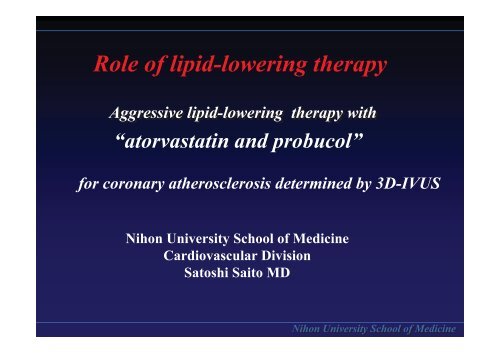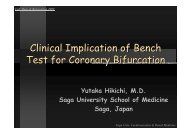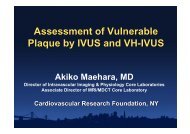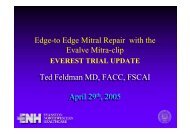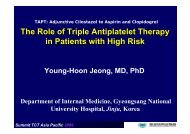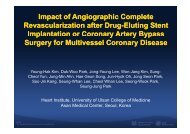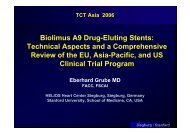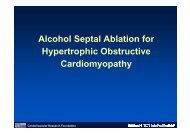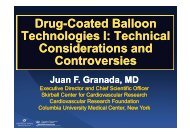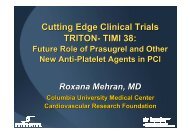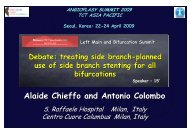Nihon University School of Medicine - summitMD.com
Nihon University School of Medicine - summitMD.com
Nihon University School of Medicine - summitMD.com
Create successful ePaper yourself
Turn your PDF publications into a flip-book with our unique Google optimized e-Paper software.
Role <strong>of</strong> lipid-lowering therapy<br />
Aggressive lipid-lowering therapy with<br />
“atorvastatin and probucol”<br />
for coronary atherosclerosis determined by 3D-IVUS<br />
<strong>Nihon</strong> <strong>University</strong> <strong>School</strong> <strong>of</strong> <strong>Medicine</strong><br />
Cardiovascular Division<br />
Satoshi Saito MD<br />
<strong>Nihon</strong> <strong>University</strong> <strong>School</strong> <strong>of</strong> <strong>Medicine</strong>
Background<br />
Glistening yellow<br />
Main findings <strong>of</strong> the current studies<br />
1) Asakura et al. used angioscoy to show that yellow plaque,<br />
indicating potentially vulnerable plaque, was observed with<br />
equal frequency in infarct-related and non-infarct-related arteries.<br />
2) Plaque ruptures occur not only in patients with MI or unstable<br />
angina, but are also found in patients with stable angina or<br />
no symptoms.<br />
3) Multiple ruptuers were seen in 15% <strong>of</strong> patients in the current<br />
population.<br />
4) Ruptured plaques are usually eccentric with positive remodeling.<br />
G.Rioufol et al. Circulation. 2002; 106:804, Moriuchi M, Saito S, et al. Heart and Vessels, 1997<br />
A.Maehara et al. JACC. 2002;40:904, JACC 2002;40:904, JACC 2001, 37:1284<br />
<strong>Nihon</strong> <strong>University</strong> <strong>School</strong> <strong>of</strong> <strong>Medicine</strong>
Such lesions frequently appear as non-significant or<br />
mild to moderate stenosis on coronary angiography.<br />
Plaque rupture <strong>of</strong> the lesion leads to acute coronary<br />
IVUS syndrome .<br />
CAG<br />
Background<br />
Eccentric s<strong>of</strong>t lesion with<br />
lipid pool and positive remodeling<br />
Angiographically non-significant<br />
Stenosis<br />
<strong>Nihon</strong> <strong>University</strong> <strong>School</strong> <strong>of</strong> <strong>Medicine</strong>
Background<br />
Therefore, it has been emphasized that treatment<br />
to achieve lesion stability and/or regression is beneficial.<br />
Large primary and secondary prevention trials with<br />
Statin have demonstrated that lipid-lowering therapy<br />
was effective or preventing cardiac events.<br />
<strong>Nihon</strong> <strong>University</strong> <strong>School</strong> <strong>of</strong> <strong>Medicine</strong>
Background<br />
Recent studies show that<br />
1) Aggressive LDL-C lowering with HMG-CoA<br />
reductase inhibition, atorvastatin, likely leads to<br />
a slowdown <strong>of</strong> plaque growth and a change in<br />
plaque <strong>com</strong>position.(GAIN)<br />
2) Reversal study<br />
3) Probucol has been reported to prevent atherogenesis<br />
by acting as an anti-oxidant and suppressing the<br />
oxidative modification <strong>of</strong> LDL-C and Probucol could<br />
stabilize plaque.<br />
M. Schartl et al. Circulation; 104:387<br />
Y. Sasayama et al. JACC; 39:610<br />
<strong>Nihon</strong> <strong>University</strong> <strong>School</strong> <strong>of</strong> <strong>Medicine</strong>
REVERSAL<br />
The REVERSing Atherosclerosis with Aggressive<br />
Lipid Lowering Study<br />
Nissen SE et al. JAMA 2004 291:1071-80<br />
<strong>Nihon</strong> <strong>University</strong> <strong>School</strong> <strong>of</strong> <strong>Medicine</strong>
REVERSAL trial<br />
1. 654 patients enrolled and 502 had evaluated<br />
by IVUS at baseline and 18mo follow up after<br />
lipid lowering therapy with Pravastatin 40mg<br />
or Atorvastatin 80mg for the patients with<br />
coronary artery disease.<br />
• Volumetric IVUS analysis was performed for<br />
plaque volume.<br />
Nissen SE et al. JAMA 2004 291:1071-80<br />
<strong>Nihon</strong> <strong>University</strong> <strong>School</strong> <strong>of</strong> <strong>Medicine</strong>
Changes <strong>of</strong> plaque volume<br />
<br />
<br />
<br />
<br />
<br />
<br />
<br />
<br />
<br />
<br />
<br />
<br />
<br />
<br />
<br />
<br />
<br />
†<br />
<br />
<br />
<br />
<br />
<br />
The plaques in Pravastatin group still<br />
progressed, however the progression<br />
rather stopped in Atorvastatin group.<br />
<br />
<br />
† <br />
Nissen SE et al. JAMA 2004 291:1071-80<br />
<strong>Nihon</strong> <strong>University</strong> <strong>School</strong> <strong>of</strong> <strong>Medicine</strong>
Background<br />
Recent studies show that<br />
1) Aggressive LDL-C lowering with HMG-CoA<br />
reductase inhibition, atorvastatin, likely leads to<br />
a slowdown <strong>of</strong> plaque growth and a change in<br />
plaque <strong>com</strong>position. (GAIN)<br />
2) Reversal study<br />
3) Probucol has been reported to prevent atherogenesis<br />
by acting as an anti-oxidant and suppressing the<br />
oxidative modification <strong>of</strong> LDL-C and Probucol could<br />
stabilize plaque.<br />
M. Schartl et al. Circulation; 104:387<br />
Y. Sasayama et al. JACC; 39:610<br />
<strong>Nihon</strong> <strong>University</strong> <strong>School</strong> <strong>of</strong> <strong>Medicine</strong>
Therapeutic Strategy <strong>of</strong> ACS<br />
Aggressive LDL-C lowering<br />
Suppressing the oxidative modification <strong>of</strong> LDL-C<br />
<strong>Nihon</strong> <strong>University</strong> <strong>School</strong> <strong>of</strong> <strong>Medicine</strong>
Purpose<br />
To evaluate the <strong>com</strong>bined effects <strong>of</strong> aggressive<br />
LDL-C lowering therapy with atorvastatin and<br />
anti-oxidant therapy with probucol on changes in<br />
plaque volume and echogenicity by intravascular<br />
ultrasound (IVUS).<br />
<strong>Nihon</strong> <strong>University</strong> <strong>School</strong> <strong>of</strong> <strong>Medicine</strong>
Methods: Patients<br />
1. 65 non-culprit lesions in patients with ACS<br />
2. Mild to moderate lesion (< 50% on QCA)<br />
3. Baseline and follow-up studies (> 6 months) with<br />
CAG and IVUS (volmetric and densitometric<br />
analysis)<br />
4. 3 groups according to LDL-C level:<br />
Group A (Atorvastatin): LDL-C 140 mg/dl<br />
Group P (Probucol): LDL-C < 140 mg/dl<br />
Group A+P: LDL-C 140 mg/dl<br />
<strong>Nihon</strong> <strong>University</strong> <strong>School</strong> <strong>of</strong> <strong>Medicine</strong>
Methods: Study Design<br />
Medication:<br />
Group A: atorvastatin 10mg/day<br />
Group P: probucol 500mg/day<br />
Group A+P: atorvastatin 10mg/day<br />
and probucol 500mg/day<br />
<strong>Nihon</strong> <strong>University</strong> <strong>School</strong> <strong>of</strong> <strong>Medicine</strong>
IVUS analysis<br />
1. 40MHz Atrantis (Boston Scientific Scimed Inc.)<br />
2. Using an automatic motor drive unit and pullback<br />
speed at 0.5mm/sec<br />
3. Off-line volumetric IVUS analysis<br />
(Netra IVUS, Scimage)<br />
Lumen volume<br />
Vessel volume<br />
Plaque volume<br />
<strong>Nihon</strong> <strong>University</strong> <strong>School</strong> <strong>of</strong> <strong>Medicine</strong>
Texture Videodensitometric Analysis<br />
1. Using Contrast Time Analist in Cardio 2000<br />
Win (Fukuda Denshi Co. Ltd.)<br />
2. Contrast Time Investigation analyzes the<br />
change <strong>of</strong> contrast (gray values) in a sequence<br />
<strong>of</strong> IVUS images.<br />
3. Regions <strong>of</strong> interest (ROI)<br />
4. Gray scales (between black and white, divided<br />
into 256 values) for echogenicity.<br />
<strong>Nihon</strong> <strong>University</strong> <strong>School</strong> <strong>of</strong> <strong>Medicine</strong>
Texture Videodensitometric Analysis<br />
Regions <strong>of</strong> interest (ROI)<br />
ROI plaque<br />
ROI adventitia<br />
Average gray scale <strong>of</strong> the lesion for plaque echogenicity.<br />
<strong>Nihon</strong> <strong>University</strong> <strong>School</strong> <strong>of</strong> <strong>Medicine</strong>
Patient Characteristics<br />
Group A Group P Group A+P<br />
(n=23) (n=21) (n=21)<br />
Age (mean) 62.212.0 64.48.3 57.65.2<br />
Follow-up period 6.82.1 6.41.2 6.41.1<br />
Previous MI 5 (50%) 8 (80%) 6 (60%)<br />
LAD 10 (40%) 8 (20%) 7 (30%)<br />
LCX 7 (40%) 6 (20%) 5 (20%)<br />
RCA 6 (20%) 7 (60%) 9 (50%)<br />
Smoking 15 (70%) 14 (80%) 16 (80%)<br />
Hyperlipidemia 15 (70%) 14 (70%) 15 (80%)<br />
Hypertention 14 (70%) 9 (40%) 10 (40%)<br />
Diabetes Mellitus 5 (0%) 7 (40%) 5 (20%)<br />
Family history 4 (20%) 3(10%) 4 (20%)<br />
<strong>Nihon</strong> <strong>University</strong> <strong>School</strong> <strong>of</strong> <strong>Medicine</strong>
Changes in Total Cholesterol<br />
250<br />
200<br />
150<br />
100<br />
*<br />
*<br />
*<br />
Baseline<br />
Follow-up<br />
50<br />
0<br />
Group A Group P<br />
Group<br />
A+P<br />
* p < 0.05<br />
<strong>Nihon</strong> <strong>University</strong> <strong>School</strong> <strong>of</strong> <strong>Medicine</strong>
Changes in LDL-C<br />
200<br />
150<br />
100<br />
50<br />
* *<br />
*<br />
Baseline<br />
Follow-up<br />
0<br />
Group A Group P<br />
Group<br />
A+P<br />
* p < 0.05<br />
<strong>Nihon</strong> <strong>University</strong> <strong>School</strong> <strong>of</strong> <strong>Medicine</strong>
% Change in atheroma volume<br />
<br />
<br />
<br />
<br />
<br />
<br />
<br />
*<br />
<br />
<br />
<br />
* p
% change in Lumen volume<br />
<br />
<br />
<br />
<br />
<br />
*<br />
<br />
<br />
<br />
* p
% changes in vessel volume<br />
<br />
<br />
<br />
<br />
<br />
<br />
<br />
<strong>Nihon</strong> <strong>University</strong> <strong>School</strong> <strong>of</strong> <strong>Medicine</strong>
% changes in plaque echogenicity<br />
(%)<br />
100<br />
*<br />
75<br />
50<br />
*<br />
25<br />
0<br />
Group P Group A Group A+P<br />
* p < 0.05<br />
Improvement rate (%)<br />
Plaque GV (follow)Plaque GV (baseline / Plaque GV (baseline) 100<br />
<strong>Nihon</strong> <strong>University</strong> <strong>School</strong> <strong>of</strong> <strong>Medicine</strong>
Coronary angiography<br />
Baseline<br />
Probucol + Atorvastatin<br />
67y/o, Male<br />
<strong>Nihon</strong> <strong>University</strong> <strong>School</strong> <strong>of</strong> <strong>Medicine</strong>
Changes in Plaque Area and Echogenicity<br />
Before treatment<br />
Atorvastatin + Probucol<br />
LDL-C 146 mg/dl<br />
LDL-C 68 mg/dl<br />
Plaque area:14.96mm 2 Plaque area: 13.67mm 2<br />
Mean gray value: 52.0 Mean gray value: 65.3<br />
M.I., 67y.o. RCA, Male<br />
<strong>Nihon</strong> <strong>University</strong> <strong>School</strong> <strong>of</strong> <strong>Medicine</strong>
LDL 146 mg/dl<br />
3D-IVUS measurements<br />
Baseline<br />
LDL 68 mg/dl<br />
6 mo f/p<br />
<strong>Nihon</strong> <strong>University</strong> <strong>School</strong> <strong>of</strong> <strong>Medicine</strong>
Summary<br />
1. Increase in echogenicity on<br />
videodensitometric analysis was<br />
recognized in all groups, especially in<br />
Group A+P > Group P.<br />
2. Significant reduction in plaque volume<br />
with con<strong>com</strong>itant increase in lumen<br />
volume was obtained in Group A+P.<br />
<strong>Nihon</strong> <strong>University</strong> <strong>School</strong> <strong>of</strong> <strong>Medicine</strong>
Conclusions<br />
1. LDL-C should be reduced less than 100 mg/dl<br />
to slowdown or stop plaque growth.<br />
2. Anti-oxidant therapy with probucol might<br />
stabilize plaque <strong>com</strong>position.<br />
3. Combination therapy with atorvastatin and<br />
probucol may lead to plaque regression and<br />
stabilization <strong>of</strong> minor lesions.<br />
4. This therapy could be very useful to prevent<br />
cardiac events after PCIs.<br />
5. First report <strong>of</strong> plaque regression!<br />
<strong>Nihon</strong> <strong>University</strong> <strong>School</strong> <strong>of</strong> <strong>Medicine</strong>


